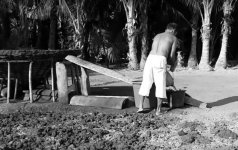Real of Tayopa
Bronze Member
To warrant that much work in the form of a filtered salt, would leave an enormous pile of charcoal and other contaminates. Where are they 


To warrant that much work in the form of a filtered salt, would leave an enormous pile of charcoal and other contaminates. Where are they
Most cultures would have constructed (and did/do) pans a foot or so below Spring Tide so the highest tides would flood them and then they would be above mean ocean level so they could evaporate.
Do you have any sites in the world you can show that are similar to a pit evaporator or filter below sea level as you suggest?


To warrant that much work in the form of a filtered salt, would leave an enormous pile of charcoal and other contaminates. Where are they
Some rider; Salt was an extremely valuable product, The various producers, were tightly controlled as a side method of collecting the gov'ts taxes. . example in the patio process in mining in Mexico . It was an indirect way to collect their taxes hence all known salt producers were considered gov't only. I can't believe that an operation such as oak island would escape the Gov't eye, sooner or later someone would talk.
Depression and a mark where there might have been a pulley . . . as related by one of a group of then kids who later said they had found nothing when they dug around.
Sorry franklin, but I've never created a file for anything KGC. If I had, it would probably be thinner than most, since pretty much everything I've seen to date, including PA's theoretical propositions, has been folks trying to shove the square peg thru the round holes where other lost treasures remain. You may see it differently, but that's my take on the KGC.
Do have a rather bulky file on the Templars though, so Arcadia/Acadia IS familiar. But the most recent date in that timeline leaves a considerable gap before anything KGC shows up.

The KGC and their treasures are real. They are just very difficult to find or to recover. If the US Government would let me dig three feet I could pay off the National Deficit.